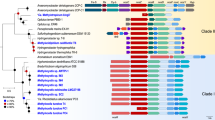Abstract
Autotrophic methanogens reduce CO2 to CO and assimilate CO in a carbonylation reaction. Heterotrophic species were found not to form CO and/or to incorporate CO into cell matiral. The absence of CO formation correlated with the absence of carbon monoxide dehydrogenase activity. The heterotrophic Methanobrevibacter ruminantium, Methanobrevibacter smithii, Methanococcus voltae and Methanospirillum hungatei (strain GP 1) were investigated.
Similar content being viewed by others
References
Balch WE, Fox GE, Magrum LJ, Woese CR, Wolfe RS (1979) Methanogens: Reevaluation of a unique biological group. Microbiol Rev 43:260–296
Bott M (1985) CO-Dehydrogenase und CO-Bildung in methanogenen Bakterien. Diploma thesis, Marburg
Breuil C, Patel GB (1980) Composition of Methanospirillum hungatii GP1 during growth on different media. Can J Microbiol 26:577–582
Bryant MP, Tzeng SF, Robinson IM, Joyner AE Jr (1971) Nutrient requirements of methanogenic bacteria. In: Pohland FG (ed) Anaerobic biological treatment processes. Adv Chem Series 105:23–40
Conrad R, Thauer RK (1983) Carbon monoxide production by Methanobacterium thermoautotrophicum. FEMS Microbiol Lett 20:229–232
Daniels L, Fuchs G, Thauer RK, Zeikus JG (1977) Carbon monoxide oxidation by methanogenic bacteria. J Bacteriol 132:118–126
Daniels L, Zeikus JG (1978) One-carbon metabolism in methanogenic bacteria: analysis of short-term fixation products of 14CO2 and 14CH3OH incorporated into whole cells. J Bacteriol 136:75–84
Diekert G, Ritter M (1983) Carbon monoxide fixation into the carboxyl group of acetate during growth of Acetobacterium woodii on H2 and CO2. FEMS Microbiol Lett 17:299–302
Eikmanns B, Thauer RK (1984) Catalysis of an isotopic exchange between CO2 and the carboxyl group of acetate by Methanosarcina barkeri grown on acetate. Arch Microbiol 138:365–370
Eikmanns B, Fuchs G, Thauer RK (1985) Formation of carbon monoxide from CO2 and H2 by Methanobacterium thermoautotrophicum. Eur J Biochem 146:149–154
Ekiel I, Smith ICP, Sprott GD (1983) Biosynthetic pathways in Methanospirillum hungatei as determined by 13C nuclear magnetic resonance. J Bacteriol 156:316–326
Ekiel I, Jarrell KF, Sprott GD (1985) Amino acid biosynthesis and sodium-dependent transport in Methanococcus voltae, as revealed by 13C NMR. Eur J Biochem (in press)
Escalante-Semerena JC, Rinehart KL Jr, Wolfe RS (1984) Tetrahydromethanopterin, a carbon carrier in methanogenesis. J Biol Chem 259:9447–9455
Fuchs G, Stupperich E (1984) CO2 reduction to cell carbon in methanogens. In: Crawford RL, Hanson RS (eds) Microbial growth on C1 compounds. Am Soc Microbiol 199–202
Fuchs G, Schnitker U, Thauer RK (1974) Carbon monoxide oxidation by growing cultures of Clostridium pasteurianum. Eur J Biochem 49:111–115
Fuchs G, Stupperich E, Thauer RK (1978) Acetate assimilation and the synthesis of alanine, aspartate and glutamate in Methanobacterium thermoautotrophicum. Arch Microbiol 117:61–66
Hammel KE, Cornwell KL, Diekert GB, Thauer RK (1984) Evidence for a nickel-containing carbon monoxide dehydrogenase in Methanobrevibacter arboriphilicus. J Bacteriol 157:975–978
Holder U, Schmidt DE, Stupperich E, Fuchs G (1985) Autotrophic synthesis of activated acetic acid from two CO2 in Methanobacterium thermoautotrophicum. III. Evidence for common one-carbon precursor pool and the role of corrinoid. Arch Microbiol 141:229–238
Jansen K, Fuchs G, Thauer RK (1985) Autotrophic CO2 fixation by Desulfovibrio boarsii: Demonstration of enzyme activities characteristic for the acetyl-CoA pathway. FEMS Microbiol Lett (in press)
Kenealy WR, Zeikus JG (1982) One-carbon metabolism in methanogens: Evidence for synthesis of a two-carbon cellular intermediate and unification of catabolism and anabolism in Methanosarcina barkeri. J Bacteriol 151:932–941
Kohler HPE, Zehnder AJB (1984) Carbon monoxide dehydrogenase and acetate thiokinase in Methanothrix soehngenii. FEMS Microbiol Lett 21:287–292
Krzycki JA, Zeikus JG (1984) Characterization and purification of carbon monoxide dehydrogenase from Methanosarcina barkeri. J Bacteriol 158:231–237
Krzycki JA, Wolkin RH, Zeikus JG (1982) Comparison of unitrophic and mixotrophic substrate metabolism by an acetate-adapted strain of Methanosarcina barkeri. J Bacteriol 149:247–254
Länge S, Fuchs G (1985) Tetrahydromethanopterin, a coenzyme involved in autotrophic acetyl coenzyme A synthesis from 2 CO2 in Methanobacterium. FEBS Lett 181:303–307
Podschun R (1980) α-Ketoglutaratsynthese in Methanobrevibacter smithii. Diploma thesis, Marburg
Rühlemann M, Ziegler K, Stupperich E, Fuchs G (1985) Detection of acetyl coenzyme A as an early CO2 assimilation intermediate in Methanobacterium. Arch Microbiol (in press)
Schönheit P, Moll J, Thauer RK (1980) Growth parameters (K s, 269-1, Y s) of Methanobacterium thermoautotrophicum. Arch Microbiol 127:59–65
Sprott GD, Jarrell KF (1981) K+, Na+, and Mg2+ content and permeability of Methanospirillum hungatei and Methanobacterium thermoautotrophicum. Can J Microbiol 27:444–451
Stupperich E, Fuchs G (1984a) Autotrophic synthesis of activated acetic acid from two CO2 in Methanobacterium thermoautotrophicum. I. Properties of in vitro system. Arch Microbiol 139:8–13
Stupperich E, Fuchs G (1984b) Autotrophic synthesis of activated acetic acid from two CO2 in Methanobacterium thermoautotrophicum. II. Evidence for different origins of acetate carbon atoms. Arch Microbiol 139:14–20
Stupperich E, Hammel KE, Fuchs G, Thauer RK (1983) Carbon monoxide fixation into the carboxyl group of acetyl coenzyme A during autotrophic growth of Methanobacterium. FEBS Lett 152:21–23
Van Beelen P, Stassen APM, Bosch JWG, Vogels GD, Guijt W, Haasnoot CAG (1984) Elucidation of the structure of methanopterin, a coenzyme from Methanobacterium thermoautotrophicum, using two dimensional nuclear-magnetic-resonance techniques. Eur J Biochem 138:563–571
Van Beelen P, Van Neck JW, Cock RM de, Vogels GD, Guijt W, Haasnoot CAG (1984) 5,10-Methenyl-5,6,7,8-tetrahydromethanopterin, a one-carbon carrier in the process of methanogenesis. Biochemistry 23:4448–4454
Whitman WB, Ankwanda E, Wolfe RS (1982) Nutrition and carbon metabolism of Methanococcus voltae. J Bacteriol 149:852–863
Zeikus JG, Wolfe RS (1972) Methanobacterium thermoautotrophicus sp. n., an anaerobic, autotrophic, extreme thermophile. J Bacteriol 109:707–713
Author information
Authors and Affiliations
Rights and permissions
About this article
Cite this article
Bott, M.H., Eikmanns, B. & Thauer, R.K. Defective formation and/or utilization of carbon monoxide in H2/CO2 fermenting methanogens dependent on acetate as carbon source. Arch. Microbiol. 143, 266–269 (1985). https://doi.org/10.1007/BF00411248
Received:
Accepted:
Issue Date:
DOI: https://doi.org/10.1007/BF00411248




